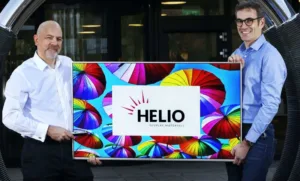Helio Display Materials, the first joint spin-out from Oxford and Cambridge Universities, has raised $4.75m of Series A finance in a round led by Longwall Venture Partners and BGF. The investment is driving a significant expansion of Helio’s team and a move to custom-built labs at the Wood Centre for Innovation in Oxford.
Simon Jones, CEO, said,
Helio is on a mission to use our world-leading perovskite science to step up the performance and efficiency of displays. This fund raising marks a change of gear for Helio, enabling us to significantly grow our capacity to design products and engage with partners in the display supply chain. I would like to thank and acknowledge our enormously supportive investors who share our vision of a bright future for perovskites in displays.
Simon Jones (CEO) and Bernard Wenger (CTO) pictured outside the Wood Centre for Innovation in Oxford UK
As part of the expansion, Helio will shortly be announcing two high profile appointments to its management team and will be advertising a series of exciting new materials development roles on its careers page.
For more on perovskites in displays, please check out the following short blog articles:
- Beyond colour gamut: How colour conversion is driving innovation in TV displays
- Why next generation TVs need perovskites
About Helio
British company Helio is creating proprietary materials for a new generation of brighter and more colourful displays that use significantly less power.
Based in Oxford, the first joint spin-out from two of the world’s highest ranked universities for research, Oxford and Cambridge, is ready to partner with companies in the display supply chain. Using the power of perovskites, Helio intends to tap into the $120 billion display module market by solving a problem facing LCD and large-area OLED displays.
Existing display technologies filter white light to provide the red, green and blue light needed for the pixels that make up the image. Filtering means that the power in the unwanted colours is lost. Perovskites are photoluminescent and can convert light directly into the desired colour which is hugely more efficient. They also emit a very narrow spectrum which maximises colour gamut, enabling the display to reproduce many more of the colours that we perceive in the real world.
Around 250 million TVs are sold in the world per year driving a very significant large-area display module market where future growth is predicted to be in higher performance displays. Helio’s materials are a key enabling technology for next generation screens whether based on LCD, OLED or µLED. Only a thin layer is needed to produce superior colours and increased power efficiency due to the very high optical absorption of perovskites.
CEO Simon Jones has nearly 20 years of display industry experience in start-ups and corporates and from materials through to end products, while Chairman Mark Verrall ran display materials development at Merck for 5 years, taking many new materials solutions from the lab to commercial sale.
Co-founders and leaders in perovskites science, Prof. Henry Snaith and Prof. Sir Richard Friend are both actively engaged in developing the product and in further R&D.

